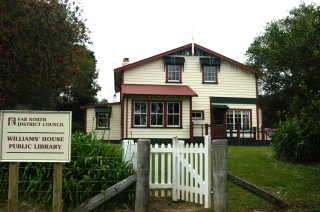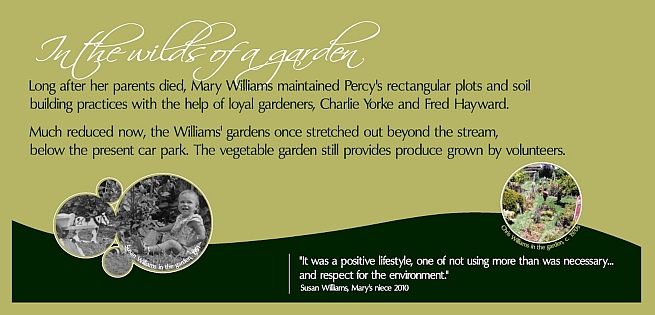 |
| Williams House History Trail |
|
The Friends of Williams House have developed a History Trail through the garden. The trail is identified by interpretive signs placed near salient features identified as having historic interest relating to Williams House. The features are numbered according to the map of the garden detailed in a brochure available from the Librarian, (which is also shown here). This brochure complements the brochure Williams House - A Legacy of Paihia's First Mission Station and is a guide to the features of the garden. Also you may see further information relating to each feature by following the links on this page. The site of Williams House was the site of various family homes from 1860 to 1993. Originally the land was owned by missionary the Reverend Henry Williams. The original house on this property was built around 1860 for his youngest daughter Lydia and her husband Hugh Carleton. The stone shed in the grounds dates from the time of the original house and was retained when the original house was demolished to make way for the existing Williams House. Because of the historical significance of the stone shed, it was registered in 1996 with the New Zealand Historic Places Trust as a Category II Historic Place, (as a place of "historical or cultural heritage significance or value"). Follow this link for the entry in the NZHPT register.. A number of trees from the original grounds are also preserved on the current site. Coupled with the additions made by later occupants that added to the historical value of the garden, this was also registered in 1996 with the New Zealand Historic Places Trust as a Category II Historic Place, (as a place of "historical or cultural heritage significance or value"). Follow this link for the entry in the NZHPT register. Following the deaths of Hugh and Lydia Carleton in the early 1890s, the land title was sold back to the Mission Trust Board, who sub-divided the original property quite substantially. In 1919, Canon Percy Temple Williams bought a number of titles and had the existing Williams House built. His property originally extended as far as the shoreline and included what is now the Village Green, the group of shops near the Post Office and the Fire Station, War Memorial Hall and carpark to the rear of the house. The homestead currently houses the Paihia Library on the ground floor. Upstairs is an art gallery and exhibits about the history of Paihia. |
 |
 |
 |
 |
|
Points of Interest on the History Trail: Starting from the path that leads in from Williams Road, (the main shopping precinct), the features of the front garden are: 1. Phoenix Palm - Phoenix canariensis [more information] 2. Pohutukawa tree - Meterosideros excelsa [more information] 3. Sweet Bay tree - Laurus nobilis [more information] 4. The rose bed [more information] 5. The front lawn - used for gala days and garden parties [more information] 6. Traditional 5-strand wire fence with rimu (a native timber) posts [more information] 7. The kissing gate [more information] 8. Bottlebrush - Callistemon citrinus [more information] 9. Olive tree - Olea europaea [more information] 10. Tecoma hedge - Tecoma capensis [more information] 11. Sheoak tree - Casurina sp. [more information] 12. Swing gate [more information] The features of the rear garden are: 13. Totara tree - Podocarpus totara [more information] 14. Corrugated iron water tank and stand [more information] 15. Raised flower beds [more information] 16. The Stone Shed [more information] The features of the orchard area are: 17. Nectarine tree – Prunus persica var. [more information] 18. Peach tree – Prunus persica cv. [more information] 19. Raised vegetable garden [more information] 20. Mandarin tree - Citrus reticulata [more information] 21. Fig tree – Ficus carica cv. [more information] 22. Loquat tree - Eriobotrya japonica [more information] 23. Plum tree – Prunus domestica [more information] 24. Site of early brick works [more information] 25. Brick well head [more information] 26. The pumphouse [more information] 27. The garage [more information] The three large, bench seats that are placed around the garden are made from macrocarpa (Monterey cypress - Cupressus macrocarpa) timber and were purchased with a grant from the Lions Foundation. The gardens are planted and maintained by volunteers and the Friends of Williams House. Heavy work, such as paving and lawn mowing is carried out by workers provided by the Far North District Council. Garden produce is sometimes sold and the proceeds are used to maintain the garden and for on-going projects of the Friends of Williams House Paihia Library. |
 |